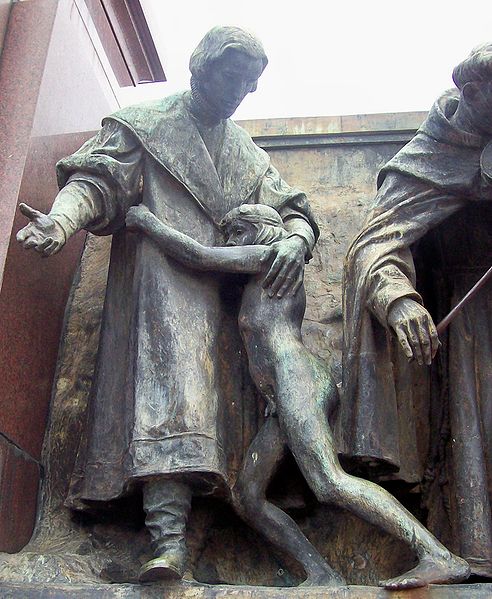<Back to Index>
- Physicist Arthur Holly Compton, 1892
- Composer Niccolò Jommelli, 1714
- Governor of Buenos Aires Hernando Arias de Saavedra, 1561
PAGE SPONSOR

Hernando Arias de Saavedra (September 10, 1561 – 1634), commonly known as Hernandarias, was a soldier and politician of criollo ancestry. He was the first American born person to become a governor of a European colony in the Americas.
Hernandarias was born in Asunción, Paraguay, as the illegitimate son of María de Sanabria and Martín Suárez, an officer under Álvar Núñez Cabeza de Vaca. He also had a sister, Juana de Saavedra, who later married Juan de Garay, the father of Jerónima de Contreras. His maternal grandparents were Diego de Sanabria and Mencia Calderón de Sanabria who were wealthy from their holdings in Paraguay. He began his military career at an early age and participated in the exploration and conquest of the territory of what is now Paraguay and Argentina. His talents as an officer and administrator led to his being named lieutenant governor of Asunción in 1592 by Juan Ramírez Velasco, and he went on to serve three terms. While claiming most officials from Spain or Peru were lazy or corrupt, on Hernandarias, the new governor Diego Rodríguez Valdés Vanda y Lugarteniente wrote:
|
|
In the same period, his half-brother Hernando de Trejo was named bishop of the see of Asunción. In 1596 he was elected as Lieutenant Governor of the Rio de la Plata province, including Buenos Aires. In 1597, upon the death of governor Valdés Vanda, King Phillip II ordered captain Francisco de Barraza to name a new governor of the province of Rio de la Plata. Hernandarias was elected unanimously by the caudillo in Asuncion as the governor of Rio de la Plata province, including Buenos Aires. Hernandarias would go on to serve three terms as governor: 1597 - 1599, 1602 – 1609, and 1615 - 1617. As
governor, Hernandarias enacted a number of policies to stimulate the
growth of what was at that time a small port town. These included the
creation of the first primary schools, kilns for creating bricks and tiles to replace adobe as a construction material, and the rebuilding of a fortress to protect the city from pirates. Following the capture of two anchored ships by English privateers on March 18, 1607, he ordered the construction of a larger fort at the mouth of the Matanza River in what is now the neighborhood of Vuelta de Rocha. He also enacted measures against smuggling caused by prohibitions on import, export and the African slave trade. During his term as governor of Buenos Aires, Hernandarias started several expeditions, including ones to Uruguay and Brazil to rein in the Portuguese bandeirantes, explore the Patagonia, survey the navigability of rivers and to find the mythical City of the Caesars. Eventually in 1604 he was captured by the native Mapuche around 1,000 km south of Buenos Aires but managed to escape with his life. In 1603, Hernandarias changed the rules on Amerindian workers bringing about the end of the mita and encomienda labor systems through which the Spanish enjoyed the fruits of native labor in exchange for converting them to Christianity. He obtained approval for this reform from King Phillip III and in 1608 arranged the creation of the Jesuit and Franciscan reductions in the region of Guayrá (modern Paraguay). In 1611, visiting judge Francisco de Alfaro ordered the emancipation of all natives working on encomiendas who had been converted by the Jesuits in his famous Ordenanzas de Alfaro. Hernandarias was directly involved in the relocation of the church in Buenos Aires in 1603. In 1616 it was determined that the church's roof was deteriorating, and, in the course of repairs the church collapsed. In 1618 Hernandarias led the effort to construct the Cathedral of Buenos Aires. Working
with carpenter Pascual Ramírez, Hernandarias secured a supply of
lumber from Paraguay as well as labor from Spanish colonists and
natives who had converted to Christianity. On the construction of the Cathedral, Hernandarias later said in a letter:
Hernandarias' impact on the development of Paraguay and Argentina is remembered in the Hernandarias District of Paraguay the city of Hernandarias, Argentina in Paraná District, and the Hernandarias Subfluvial Tunnel in Argentina.
On
September 7, 1614 Hernandarias was named governor of Buenos Aires for
his third and final term and assumed the post on May 29, 1615. He introduced the initiative to split the Río de la Plata district in two: the Province of Buenos Aires,
and the Province of Paraguay, including the settlements of
Asunción, Santiago de Jerez, Villa Rica and Ciudad Real. Though
ordered in 1617, the partition needed the approval of the king which
was granted in 1618, but
was not carried out until 1620. After the expiry of his term in 1617, he was succeeded as governor by Diego de Góngora. In his personal life, he was married to Jerónima de Contreras with whom he had three daughters: Gerónima, Isabel and María. Hernandarias retired to Santa Fe and died in 1634 at the age of 72. His remains and those of his wife were interred at the convent of San Francisco, in Santa Fe.